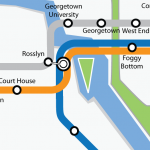
The planned Metrorail Line to Dulles Airport will provide a high-frequency, high-capacity link between the airport and the region’s core, and will enable travel between all Metrorail stations and the airport, without requiring rail-to-bus transfers. Concerns have been expressed about the likely Metrorail travel times between the airport and the core, and the capacity of the Metrorail system, as trains converge through Rosslyn and pass under the Potomac River. Could there be improvements that would provide faster service, expand the capacity, and also provide for greater flexibility for routing trains when service is disrupted, because of either incidents or planned major maintenance?
To attract riders, transit travel times need to “be competitive with” other travel options, yet setting that competitive bar at the level of auto travel times doesn’t seem to be necessary (nor is it readily achievable.) Reagan National Airport attracts many transit trips, even though driving times to the airport are generally shorter than by rail. While travel times need to be competitive, and a faster travel time would be more appealing and attract some more ridership, Metrorail to Dulles Airport will result in considerable transit usage by airport patrons and employees, not only to and from the core, but to Tysons Corner and other locations served by the Metrorail network.
Read more…
 In January 2011 we continued to provide the TAG with model results of several strategies designed to provide more access to transit. The model results of these strategies highlight the myriad methods that can be employed to meet future transit demand in the Washington metropolitan area. During this presentation we also presented the proposed RTSP public engagement strategy; a revised project schedule and solicited jurisdictional representatives for additional strategies they would like to see modeled.
In January 2011 we continued to provide the TAG with model results of several strategies designed to provide more access to transit. The model results of these strategies highlight the myriad methods that can be employed to meet future transit demand in the Washington metropolitan area. During this presentation we also presented the proposed RTSP public engagement strategy; a revised project schedule and solicited jurisdictional representatives for additional strategies they would like to see modeled.
TAG Meeting #6 Presentation (PDF)
The purpose of this strategy is to allow different rail lines to operate on the same track. This type of operation can help reduce capacity constraint on some lines and provide new connections between existing Metrorail lines.
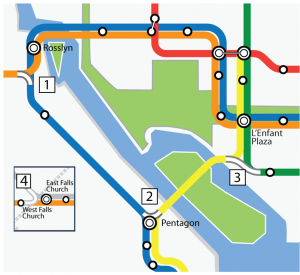 The four interline connections proposed include:
The four interline connections proposed include:
1) Connect Orange and Blue at Rosslyn
2) Connect Yellow and Blue at Pentagon
3) Connect Yellow and Green near L’Enfant Plaza
4) Connect Orange and Silver near West Falls Church
Some benefits of these interline connections include:
- Orange/Silver-Blue inter-lining south of Rosslyn to allow a Silver Line running between the two airports
- BENEFIT: Faster trip to Ballston, Tysons and airports within Virginia
- Blue-Yellow inter-lining north of Pentagon to allow I-66 corridor rail lines going through 14th Street Bridge
- BENEFIT: Utilize throughput capacity on 14th Street Bridge
- Yellow-Green inter-lining south of L’Enfant Plaza to allow a Yellow Line split to Anacostia/Navy Yard
- BENEFIT: Allow direct access between Anacostia and southern Maryland to job sites in southern Arlington and the City of Alexandria.
Additionally, this strategy will explore the benefits of making improvements to several of the system’s core stations:
- Pedestrian tunnel between Farragut North and Farragut West;
- Pedestrian tunnel between Metro Center and Gallery Place;
- Increase amount of vertical capacity at Union Station;
- Increase transfer capacity at the three core transfer stations: Metro Center, Gallery Place and L’Enfant Plaza
Will the regional transit system be up to the challenge of meeting the Transportation Planning Board (TPB) Vision’s objectives and the Greater Washington 2050 Coalition Region Forward’s targets, especially for a higher transit mode share in 2040?
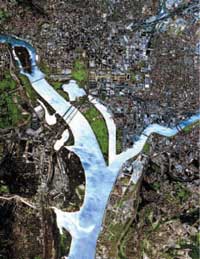
Image from mwcog.org
In early 2010, the Metropolitan Washington Council of Governments endorsed Region Forward. It includes goals, objectives and targets for the metropolitan area in 2050, relating to accessibility, sustainability, prosperity and livability. Transportation is one of nine categories among its goals, and the transportation targets draw heavily from the TPB Vision that was adopted in 1998. The Regional Transit System Plan (RTSP) is intended to help develop strategies to achieve Region Forward’s goals, objectives and targets. Several of these targets are focused on transit, and are compatible with the goals of the RTSP. What follows is a listing of Region Forward’s transit-focused goals, and how a future including an implemented RTSP may help achieve them.
Priority for management, performance, maintenance, and safety
This target echoes an objective in the TPB Vision and is intended to insure that investment in existing transportation infrastructure continues as a top priority. For example, Virginia’s funding for roads follows this philosophy, by funding road maintenance and operations off the top of revenues. That philosophy would be advantageous for transit, too, so that investments in new infrastructure wouldn’t result in disinvestment in the existing bus and rail infrastructure that continues to be needed.
RTSP is evaluating an “Enhanced Surface Transit” strategy, in which the network of 24 Metrobus Priority Corridors (PCN’s) are enhanced with bus priority treatments, intended to increase performance of surface transit service in the region while reducing overall operating costs. The RTSP will also look into new surface transit connections with an eye towards interoperability, which would help reduce costs of managing and maintaining different new light rail and streetcar systems. Read more…
October 21, 2010

In the fall, we continued to provide the TAG with model results of several strategies designed to support the goals of increasing core capacity, providing adequate access and enhancing surface transit. The model results of these strategies highlight the myriad methods that can be employed to meet the goals of the RTSP and their varied impacts, ranging from moderate to significant.
TAG Meeting 05 – October 21 2010 FINAL (PDF, 3.86MB)
Metro’s Transit Service Expansion Plan (TSEP) of 1999 is comprised of four major elements that form the backbone of a regional transit system. This post is intended to highlight the status of projects implemented under the two elements of the plan that call for expansion of the region’s fixed-guideway transit system. The first involves selectively adding stations, entrances, and station capacity to the existing Metrorail system. Specifically, the plan calls for two new stations, four new station entrances, and expansion of station capacity at four existing stations. The second element of the Metro’s current plan that emphasizes system expansion focuses on the expansion of fixed-guideway systems – whether the mode is Metrorail, light-rail (LRT), other rail technology or busways. 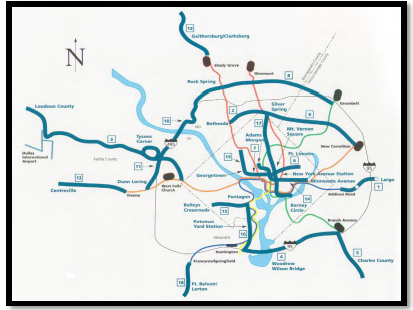 The areas served by this element of the plan are illustrated on the map shown. Under this element, the goal is to provide for at least 50-percent expansion of the region’s fixed guideway systems over the 25-year planning horizon. Below are two tables that outline the status of the station and fixed-guideway projects in the plan.
The areas served by this element of the plan are illustrated on the map shown. Under this element, the goal is to provide for at least 50-percent expansion of the region’s fixed guideway systems over the 25-year planning horizon. Below are two tables that outline the status of the station and fixed-guideway projects in the plan.
How would you rate the implementation of the system expansion elements of the 1999 plan? Do you think the region is on-track to reach the goal to provide for at least 50-percent expansion of the region’s fixed guideway systems set in the 1999 plan? More importantly, do the projects that are yet to be completed represent the best ones to expand the region’s transit infrastructure over the next 15 or more years?
Read more…
July 15, 2010
 The planning process for the RTSP has been an iterative one which allows for the exchange of information and feedback from the TAG members. The fourth meeting of the TAG included a review of the model results of the Base Case or Max CLRP and these strategies: New North-South Yellow Line on 10th Street, SW/NW; and a New North-South Yellow Line on 2nd Street, SE/NE. The results of these model runs showed the impact of each of these strategies on the passengers per rail car during the peak hour and the impact of rail inter-lining at key rail transfer points like L’Enfant Plaza, Rosslyn and Metro Center. These strategies address the need to increase core rail system capacity, one of the goals of the RTSP.
The planning process for the RTSP has been an iterative one which allows for the exchange of information and feedback from the TAG members. The fourth meeting of the TAG included a review of the model results of the Base Case or Max CLRP and these strategies: New North-South Yellow Line on 10th Street, SW/NW; and a New North-South Yellow Line on 2nd Street, SE/NE. The results of these model runs showed the impact of each of these strategies on the passengers per rail car during the peak hour and the impact of rail inter-lining at key rail transfer points like L’Enfant Plaza, Rosslyn and Metro Center. These strategies address the need to increase core rail system capacity, one of the goals of the RTSP.
TAG Meeting 4 Presentation (3MB, PDF)
In 1967, the Washington Metropolitan Area Transit Authority was created under a 1966 interstate compact encompassing the District of Columbia and portions of the State of Maryland and Commonwealth of Virginia, for the purpose of planning, financing, constructing, and operating a comprehensive mass transit system for the Washington Metropolitan Region. According to Article VI of the Compact the Board shall develop and adopt, and may from time to time review and revise, a mass transit plan for the immediate and long-range needs of the compact region.
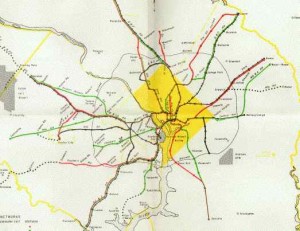
An early plan of the Metrorail system, from the online exhibit, Building the Washington Metro.
The Compact guided the development of the original Adopted Regional System (ARS) in 1968, designed to serve the region as forecast for 1990. Zachary M. Schrag, author of The Great Society Subway, hosts a website including maps and photos of the ARS, as well as an historical account of the building of Metrorail. As planning and engineering continued over the next 20-plus years, the ARS was reviewed and revised, consistent with the Compact. By the mid-1990s, planning had been completed for the ARS. Metro began to look at transit needs beyond those for which the original system had been planned, and to look at a much larger region, as forecast for 2025. Metro’s latest long-range system plan — the Transit Service Expansion Plan— was adopted in 1999.
Read more…
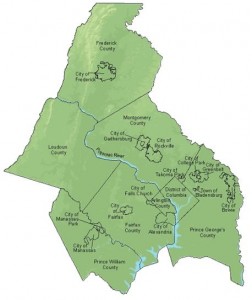 The purpose of the Regional Transit System Plan (RTSP) for 2040 is to serve as the long range transit plan including multi-modal access for the District of Columbia, Maryland, and Northern Virginia. The RTSP sets the following four project goals for the development of a comprehensive transit system plan for the region:
The purpose of the Regional Transit System Plan (RTSP) for 2040 is to serve as the long range transit plan including multi-modal access for the District of Columbia, Maryland, and Northern Virginia. The RTSP sets the following four project goals for the development of a comprehensive transit system plan for the region:
- Core Capacity – Increasing current transit capacity to the core to meet current and projected future demand and promote continued employment growth
- System Access – Improving current station access for pedestrians, cyclists, bus and automobile operators
- Surface Transit Corridors – Providing priority for surface transit corridors including express bus on HOV, rapid bus on arterials, light rail, and streetcar projects
- New and Emerging Markets – Identifying, connecting, and improving transit access to regional activity centers
What is the Technical Advisory Group (TAG)
 The RTSP Technical Advisory Group (TAG) is convened for the express purpose of reviewing the work products, data and recommendations developed by the RTSP study team during the planning process. The TAG members will be responsible for providing the team with timely information, briefing their respective organizations and informing the team of current transportation plans, proposals and operations which are relevant to the development of the RTSP 2040.
The RTSP Technical Advisory Group (TAG) is convened for the express purpose of reviewing the work products, data and recommendations developed by the RTSP study team during the planning process. The TAG members will be responsible for providing the team with timely information, briefing their respective organizations and informing the team of current transportation plans, proposals and operations which are relevant to the development of the RTSP 2040.
Read more…









 The RTSP Technical Advisory Group (TAG) is convened for the express purpose of reviewing the work products, data and recommendations developed by the RTSP study team during the planning process. The TAG members will be responsible for providing the team with timely information, briefing their respective organizations and informing the team of current transportation plans, proposals and operations which are relevant to the development of the RTSP 2040.
The RTSP Technical Advisory Group (TAG) is convened for the express purpose of reviewing the work products, data and recommendations developed by the RTSP study team during the planning process. The TAG members will be responsible for providing the team with timely information, briefing their respective organizations and informing the team of current transportation plans, proposals and operations which are relevant to the development of the RTSP 2040.
Recent Comments